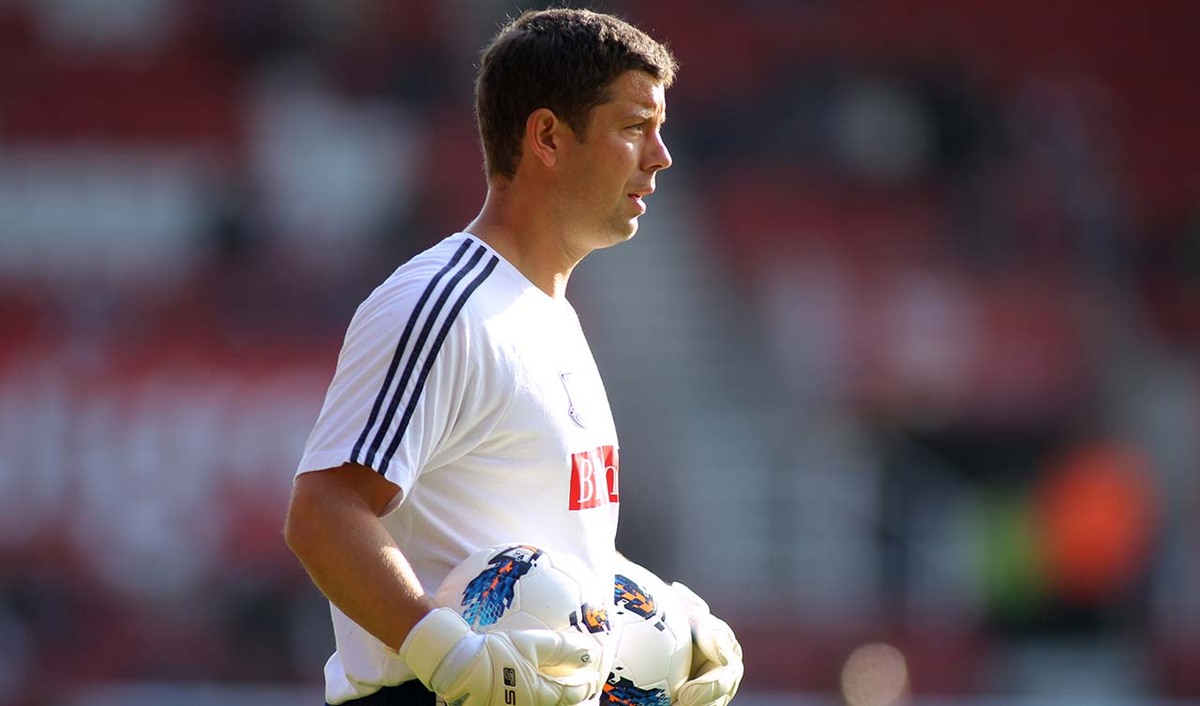Great goalkeeping

| Area | 54x36 yards |
| Equipment | Balls, cones, goal |
| No. of Players | 6 |
| Session Time | 30mins |
This is a session for goalkeepers that teaches and rehearses dealing with crosses, both opposed and unopposed, and in the context of a small-sided game.
The ability to manage balls crossed in from the wings is one of the most important parts of a goalkeeper’s game. It relies specifically on positioning, technique and good decision-making.
In coaching, crossing practices are often done for the benefit of attacker, yet they are equally important for keepers.
What do I get the players to do?
Unopposed crosses
Placing two penalty boxes opposite each other, we place goals on each side. Keepers occupy both goals with a crosser to each side in channels 5 yards wide.
Keeper 1 throws to keeper 2, who catches and distributes to either crosser to the right of him. Crossers have a maximum of three touches before delivering a ball into keeper 1. If the keeper catches the ball, he distributes to his right and the move progresses. If the cross doesn’t land in the immediate area around the keeper, or it goes behind, he must shout “away”. If this happens, keeper 2 throws another ball to the crosser to re-run the move.
1a

1b

Opposed crosses
We set up as before though add two attackers and two defenders in each half. Each keeper must instruct defenders as to their marking, body shape and positioning. Defenders must protect the keeper, block attackers, defend the goal and communicate well with one another.
2a

2b

What are the key things to look for technically/tactically?
We look for keepers to adopt good positions and to show positive body shape. They must decide quickly whether to attack the ball or defend the goal. If attacking, their line of attack is important, as is a decisive catch or punch, and their intention must be communicated to team mates. Footwork is crucial, as is taking off with the kicking leg.
If defending, they must recover quickly to the goal line and adopt a position in preparation for a potential shot at goal.
Crossers should vary their service, alternating between left and right-footed deliveries, driven balls in and whipped centres.
How would you put this into a game situation?
We conclude with a 4v4 game - as before though with two neutral wingers on each side. Each team must construct four passes in the middle before feeding out to either crossing channel. Crossers can send in deliveries or interchange passes back into the middle.
When play breaks down, restart with the keeper whose team was last out of position.
3a

3b

Editor's Picks
Attacking transitions
Deep runs in the final third
Using the goalkeeper in build-up play
Intensive boxes drill with goals
Penetrating the final third
Creating and finishing
My philosophy
Pressing initiation
Compact team movement
Coaches' Testimonials

Alan Pardew

Arsène Wenger

Brendan Rodgers

Carlos Carvalhal

José Mourinho

Jürgen Klopp

Pep Guardiola

Roy Hodgson

Sir Alex Ferguson

Steven Gerrard
Coaches' Testimonials

Gerald Kearney, Downtown Las Vegas Soccer Club

Paul Butler, Florida, USA

Rick Shields, Springboro, USA

Tony Green, Pierrefonds Titans, Quebec, Canada
Join the world's leading coaches and managers and discover for yourself one of the best kept secrets in coaching. No other training tool on the planet is written or read by the calibre of names you’ll find in Elite Soccer.
In a recent survey 92% of subscribers said Elite Soccer makes them more confident, 89% said it makes them a more effective coach and 91% said it makes them more inspired.
Get Monthly Inspiration
All the latest techniques and approaches
Since 2010 Elite Soccer has given subscribers exclusive insight into the training ground practices of the world’s best coaches. Published in partnership with the League Managers Association we have unparalleled access to the leading lights in the English leagues, as well as a host of international managers.
Elite Soccer exclusively features sessions written by the coaches themselves. There are no observed sessions and no sessions “in the style of”, just first-hand advice delivered direct to you from the coach.









